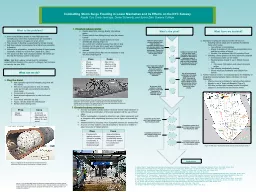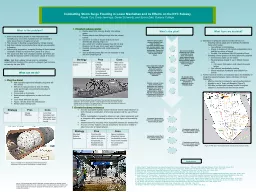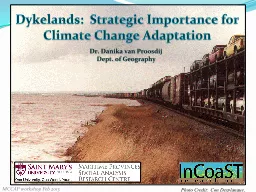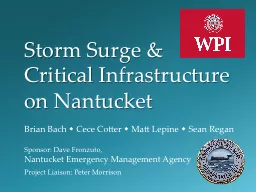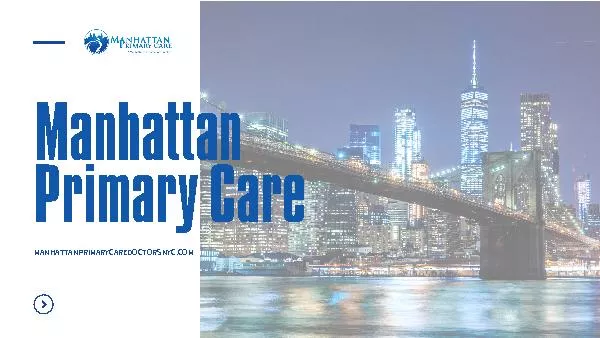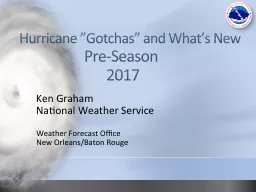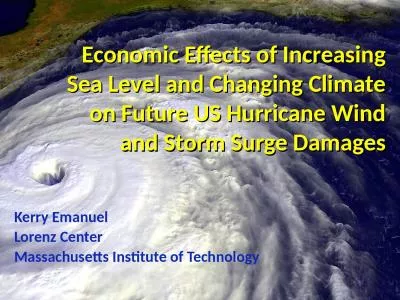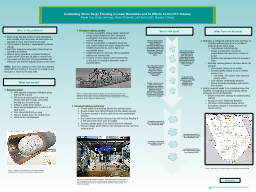PPT-Combatting Storm Surge Flooding in Lower Manhattan and its
Author : calandra-battersby | Published Date : 2016-07-22
Kayde Cox Emily Jennings Daniel Schwartz and Sylvia Zaki Queens College References Pros Cons Floodproofs station entrances Allows for subway functionality if
Presentation Embed Code
Download Presentation
Download Presentation The PPT/PDF document "Combatting Storm Surge Flooding in Lower..." is the property of its rightful owner. Permission is granted to download and print the materials on this website for personal, non-commercial use only, and to display it on your personal computer provided you do not modify the materials and that you retain all copyright notices contained in the materials. By downloading content from our website, you accept the terms of this agreement.
Combatting Storm Surge Flooding in Lower Manhattan and its: Transcript
Kayde Cox Emily Jennings Daniel Schwartz and Sylvia Zaki Queens College References Pros Cons Floodproofs station entrances Allows for subway functionality if floodwaters are shallow enough. Developed over the course of sev eral years in consultation with emergency managers broadcast meteorologists and others this new map will show eographical areas where inundation from storm surge could occur How high above ground the water could reac The need for an improved warning paradigm was first informally discussed between NHC and coastal WFOs in 2002. . I. n . 2008 NHC prepared a white paper that formally . introduced . the concept of a storm surge warning. The white . Kayde. Cox, Emily Jennings, Daniel Schwartz, and Sylvia . Zaki. , Queens College. What is the problem?. What’s the plan?. What have we decided?. What can we do?. References. 1. . Plug the drain!. With specially engineered inflatable plugs that will fill a tunnel . Con Desplanque,. Dr. Danika van Proosdij. Dept. of Geography. Dykelands. : Strategic Importance for Climate Change Adaptation . MCCAP workshop Feb 2013. Outline. Extensive low lying intertidal environments. Brian Bach . . Cece Cotter . . Matt Lepine . . Sean Regan. Sponsor: Dave Fronzuto,. Nantucket Emergency Management Agency. Project Liaison: Peter Morrison. Nature of the Problem. Our Mission. Inland Flooding. High Winds. Hurricane Katrina Vs. Isaac-----. impact. . in the state of . Mississippi. Economic impact. 3 damage categories. Katrina. : . 2 . day path through central Mississippi ,27 . Yin . Ziqi. Qingdao NO. 58 High School . Content. 1. Background. 2.. GCRA . model. 3.. The storm surge direct economic loss of empirical typical coastal province of . China. 4.. Conclusion. 1. Background. (ETSS 2.0). Pre-Implementation Briefing. College Park, MD. May 14, 2015. Arthur Taylor, . Huiqing. Liu and Ryan Schuster. MDL/NWS/NOAA. E. xtra . T. ropical . S. torm . S. urge . (. ETSS). Predicts . Working Hours: Monday:8:00 am - 7:00 pm Tuesday: 8:00 am - 7:00 pm Wednesday: 8:00 am - 7:00 pm Thursday: 8:00 am - 7:00 pm Friday: 8:00 am - 7:00 pm Saturday: Closed Sunday:CLOSED Payment: cash, check, credit cards Description: Licensed in New York, the professionals at Miller & Company have served top-tier Manhattan clients since 1997.They exceed your every expectation with full-service dedication to your financial needs. They spend time with you before delivering customize accounting strategies that improve your life and facilitate your lifestyle. Miller & Company serves New York’s elite with distinction, professionalism and responsiveness. Miller & Company leads the industry in customized, personal accounting services, delivering world class consulting, compliance and tax services. The accounting team focuses solely on your financial goals and desired outcomes. Totally invested in your success, they work with your business as if it were their own. Contact Miller & Company for tax services and QuickBooks accounting. Miller & Company caters to high net-worth individuals and thriving businesses that need a personal touch and an analytical eye. If that describes you, call Miller&Company LLP on (646) 865-1444 for innovative accounting and strategic services such as: Strategic business planning Business consulting Certified audits Tax audits Audited financial statements Corporate and personal tax preparation Tax representation Bookkeeping Miller & Company LLP 141-07 20th Ave, Suite 101 Whitestone, NY 11357 718-767-0737 274 Madison Ave, Suite 402 New York, NY 10016 (646)-865-1444 https://www.cpafirmnyc.com For more information about Manhattan Primary Care or schedule an appointment to annual physical exams at one of our two locations, please contact our Union Square office by number (212) 378-9987 or our Upper East Side NYC office by number (212) 389-9929. . Frank . Revitte. National Weather Service. Weather Forecast Office. New Orleans/Baton Rouge. 2017 Seasonal Recap. Above normal activity. 17 Total Named Storms. 7. Tropical Storms. 4. Hurricanes . CH AP T ER 4.1 C OA T A L S T ORM S W HA IS T HE HAZARD ? ROP I CA L CYC L ONE C OA T A L S T ORM S Of all hazards associated with coastal storms, coastal ooding from storm surge causes the and . Changing Climate . on . Future . US . Hurricane Wind . and . Storm Surge Damages. Kerry Emanuel. Lorenz Center. Massachusetts Institute of Technology. Program. Assessing Hurricane Event Risk. Wind. Kayde. Cox, Emily Jennings, Daniel Schwartz, and Sylvia . Zaki. , Queens College. What is the problem?. What’s the plan?. What have we decided?. What can we do?. References. Which strategy is better? .
Download Document
Here is the link to download the presentation.
"Combatting Storm Surge Flooding in Lower Manhattan and its"The content belongs to its owner. You may download and print it for personal use, without modification, and keep all copyright notices. By downloading, you agree to these terms.
Related Documents

